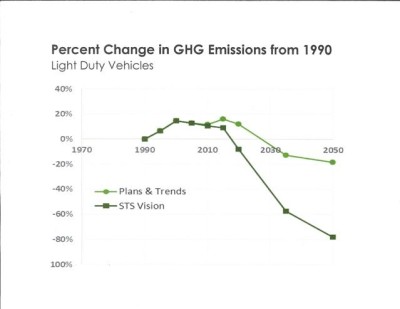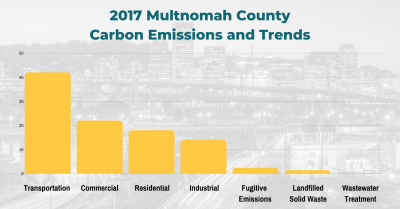Oregon Environmental Council and 1000 Friends of Oregon have a long history of partnership, especially working together to advance compact community design with a myriad of reliable alternatives to driving. When people live close to their daily destinations and have lots of transportation options, we can significantly curb climate pollution from everyday travel.
And the good news is that climate-friendly communities have lots of other benefits: the air is cleaner, the costs of getting around are lower, it’s easier to get exercise by walking and biking, they are cheaper to build and maintain, and – because they use less space – precious farm and forest lands are protected from sprawl.
But these types of communities don’t magically appear. The powers that be must re-orient transportation and land use plans toward reducing greenhouse gas emissions (GHGs), rather than ignoring the reality of climate change. Elected officials and government bodies at every level must provide affordable, reliable transportation options that safely move people and goods, rather than focusing on speedily moving cars and trucks, and assuming that everyone has access to a car.
Recognizing the critical need to change the planning mindset and to direct Oregon’s population boom in a sustainable way, 1000 Friends and OEC worked to influence the Jobs & Transportation Action of 2009. That legislation and a subsequent bill in 2010 (Senate Bill 1059) set the state on the right path by:
-
Requiring the Department of Land Conservation and Development to set targets for reducing greenhouse gas emissions from car travel in Oregon’s major metropolitan areas;
-
Requiring the state’s largest metropolitan area (Metro) to develop and adopt a land use and transportation scenario that reduces GHGs over time; and
-
Requiring ODOT to develop a Statewide Transportation Strategy to achieve necessary GHG reductions from transportation, and to provide tools and resources to help communities across the state make climate-friendly choices.
While the agencies may have “checked the box” for all of the above, implementation has been lackluster, and Oregon is failing to reduce transportation-related GHGs. A decade ago, transportation accounted for just over one-third of Oregon’s GHG emissions; it now accounts for nearly 40%. As reported by ODOT’s staff in May of 2018 (see chart below), the state will reduce transportation emissions by only 20% by 2050 under the current trajectory, a far cry from the state’s adopted GHG reduction goal of a 75% reduction in total emissions across all sectors by 2050.

We know it’s possible to reduce VMT. We know it’s possible to electrify the remaining necessary car and truck trips. And we can see where taking those goals seriously can make a difference. In the Portland region, where transportation and land use planning integrate climate goals (see Metro’s Climate Smart Strategy), per person daily vehicle miles travelled (VMT) have remained relatively flat across the Portland region since 2010. More Portlanders are on the road driving, but they aren’t driving longer distances.

But we aren’t making the progress we need to make fast enough.
That’s why 1000 Friends and OEC are working to get the state back on track. We are pleased that Governor Kate Brown recently directed ODOT, the Department of Land Conservation and Development, the Department of Environmental Quality, the Oregon Department of Energy, and their respective commissions to implement the Statewide Transportation Strategy (which, due in large part to our prodding, was finally formally adopted by the Oregon Transportation Commission in 2018) and to reinvigorate metropolitan area transportation planning to meet GHG reduction targets. See Governor Brown’s letter here.
OEC and 1000 Friends will continue to be there. We are watchdogging agency progress and asking ODOT’s soon-to-be new director, Kris Strickler, to make combating climate change front and center to ODOT’s operations. We are committed to creating vibrant, climate-friendly communities where families can save a bundle by not needing to own a car, where safe bicycling and walking opportunities help people live more healthy lives, where infrastructure costs are lower, and where the air is cleaner.
